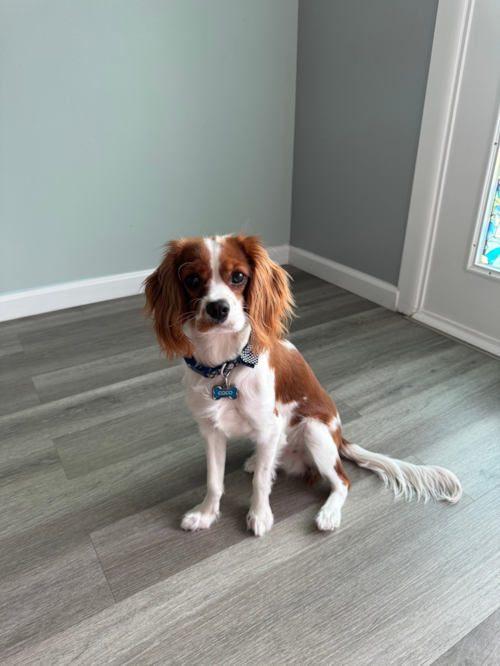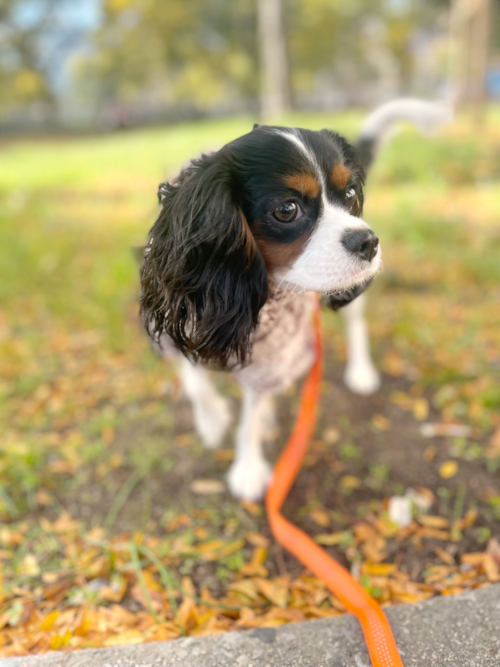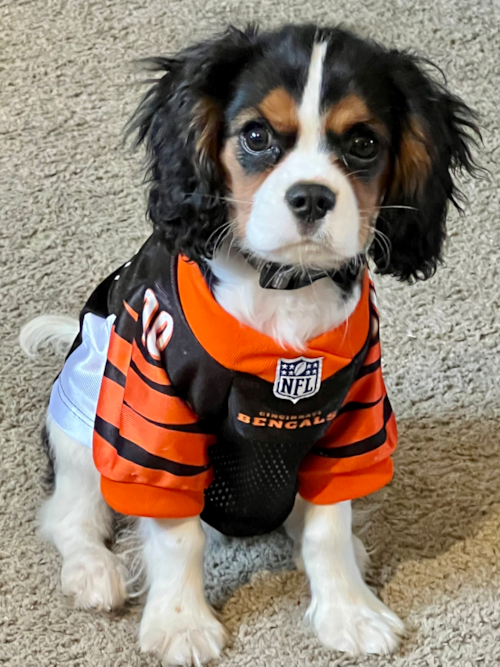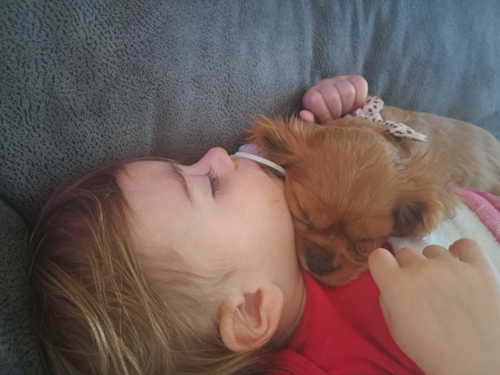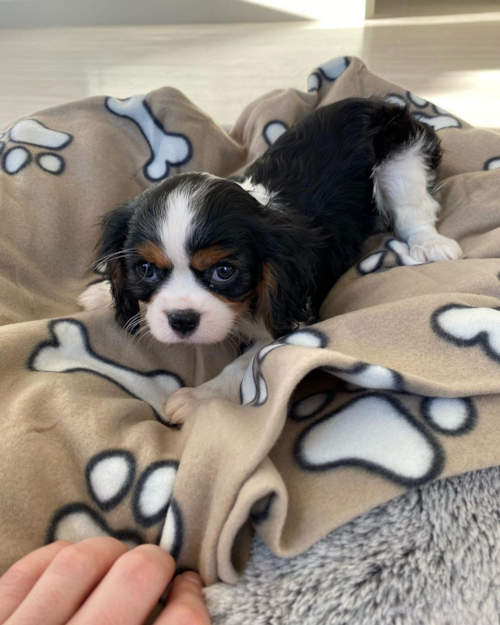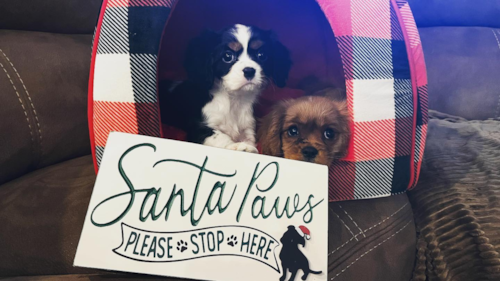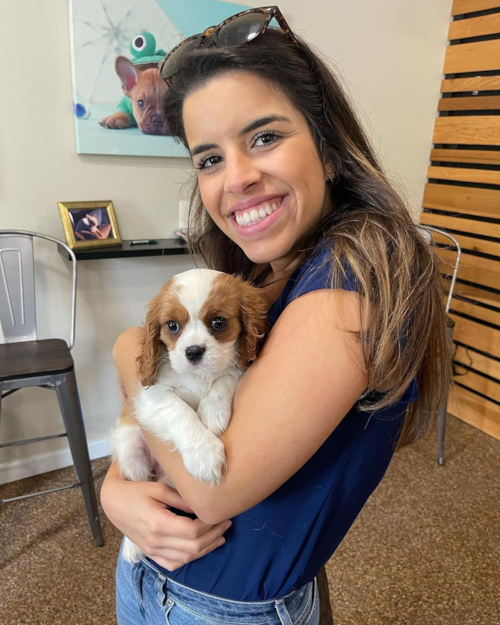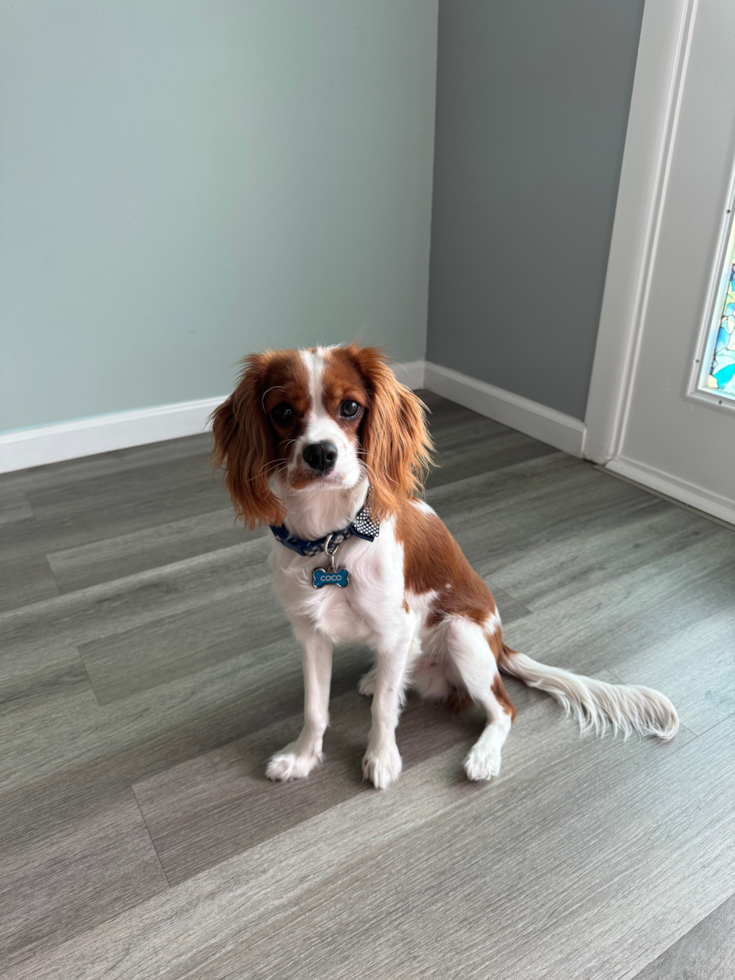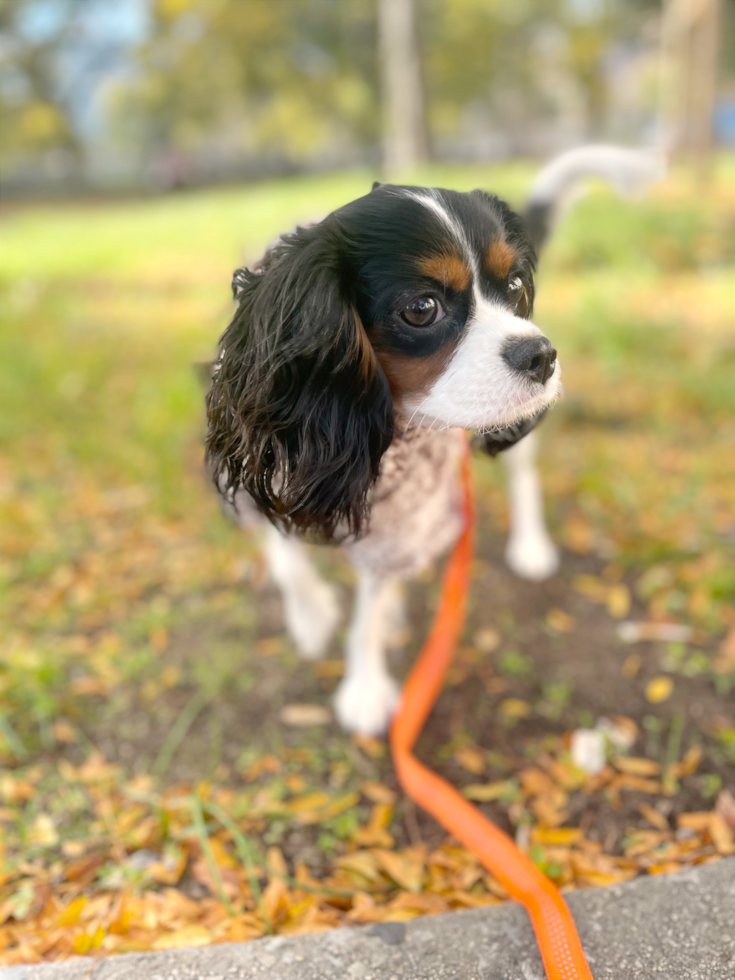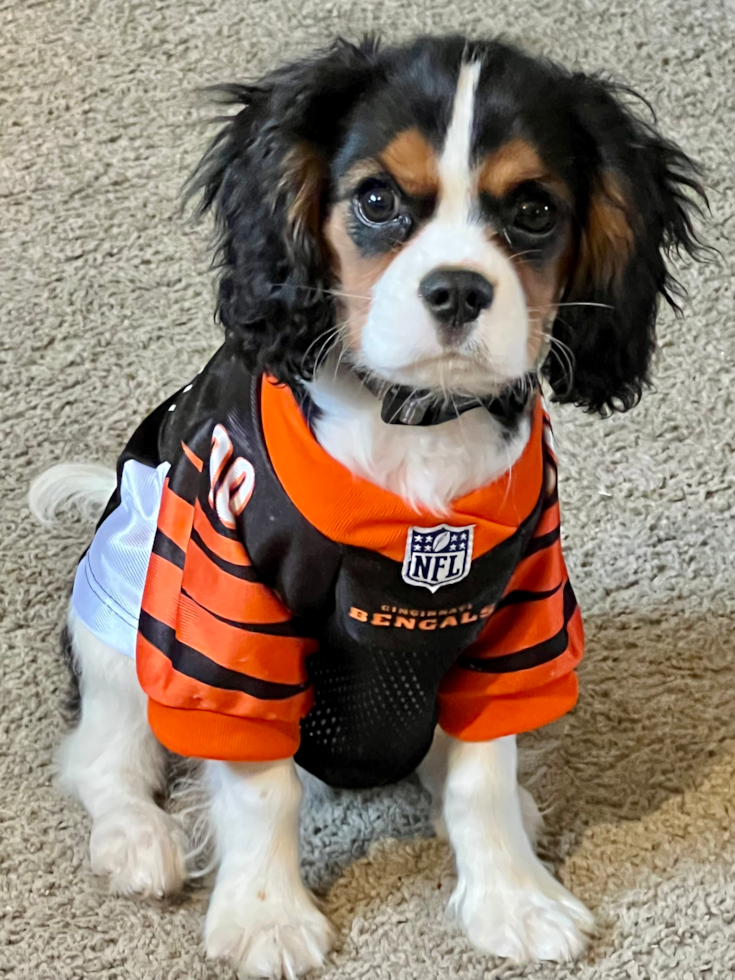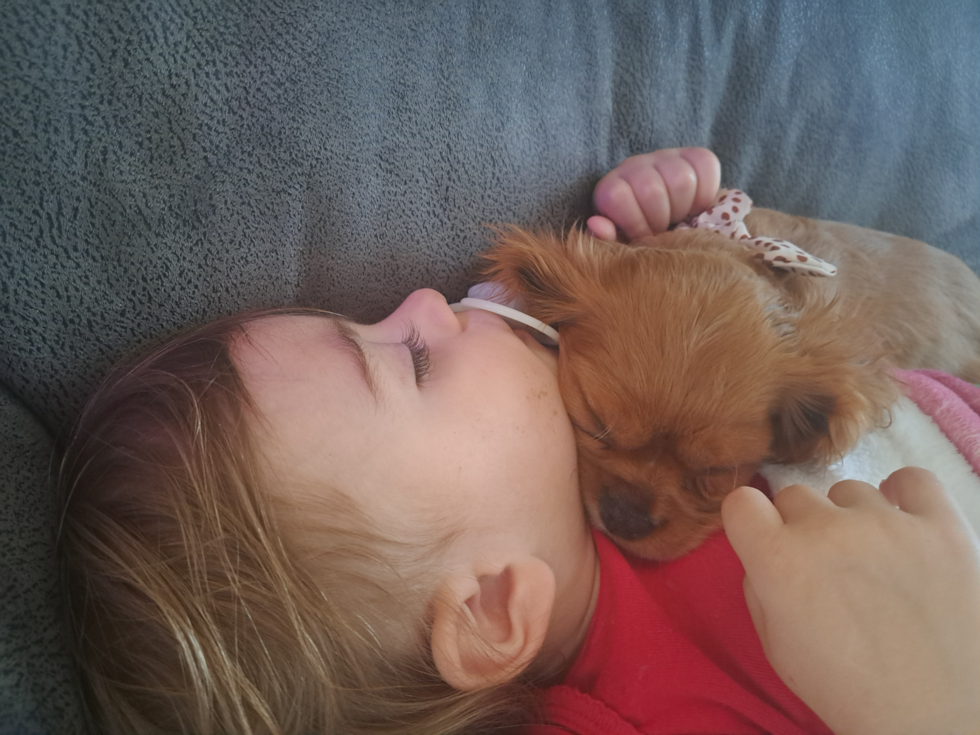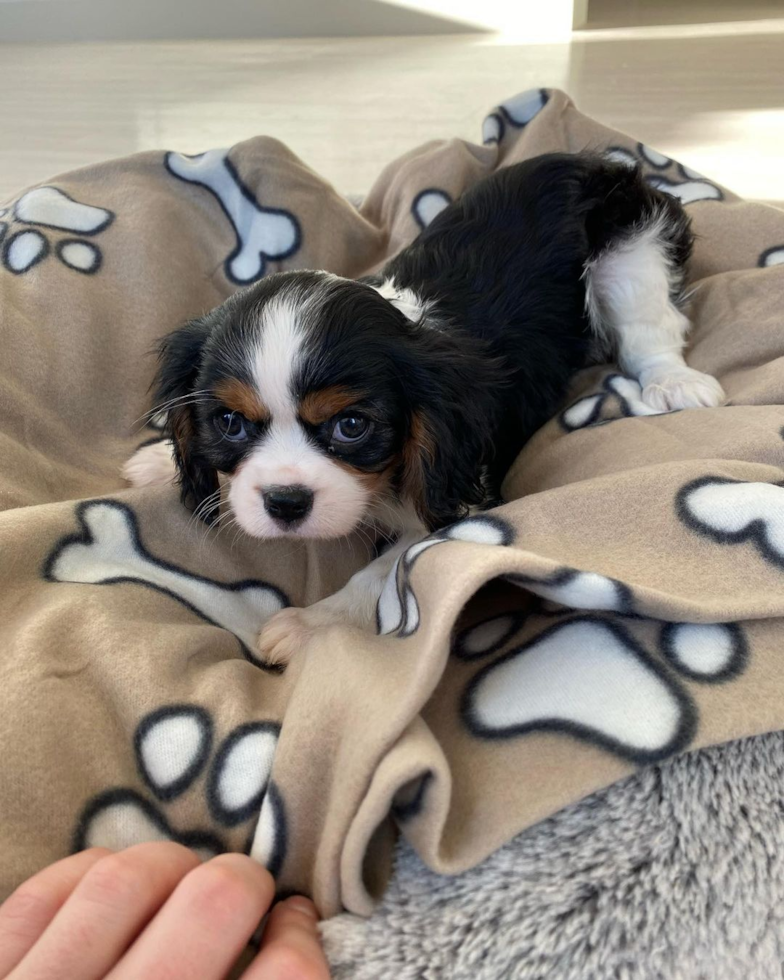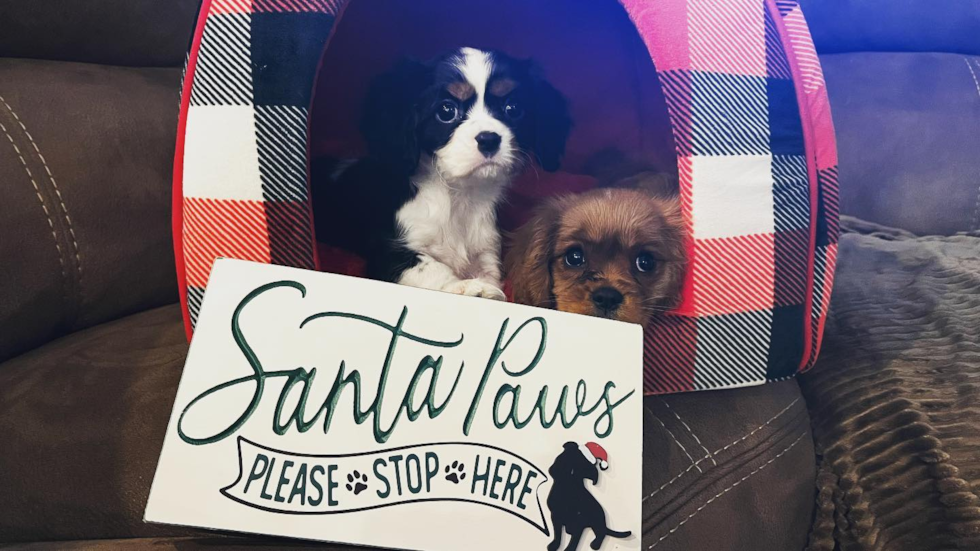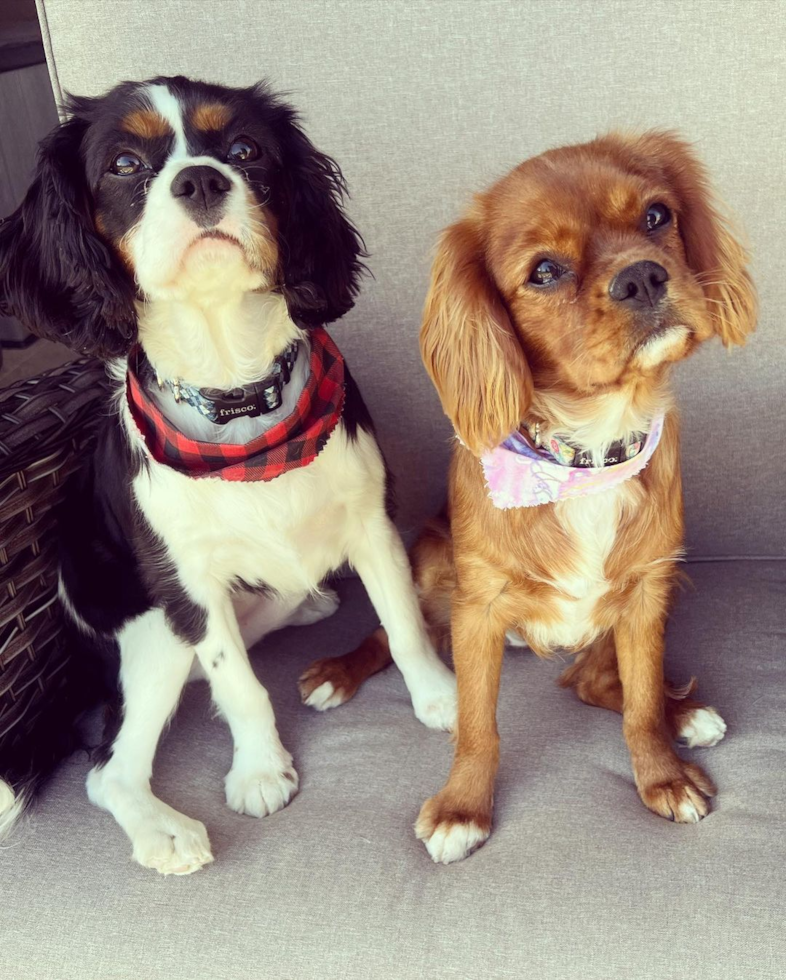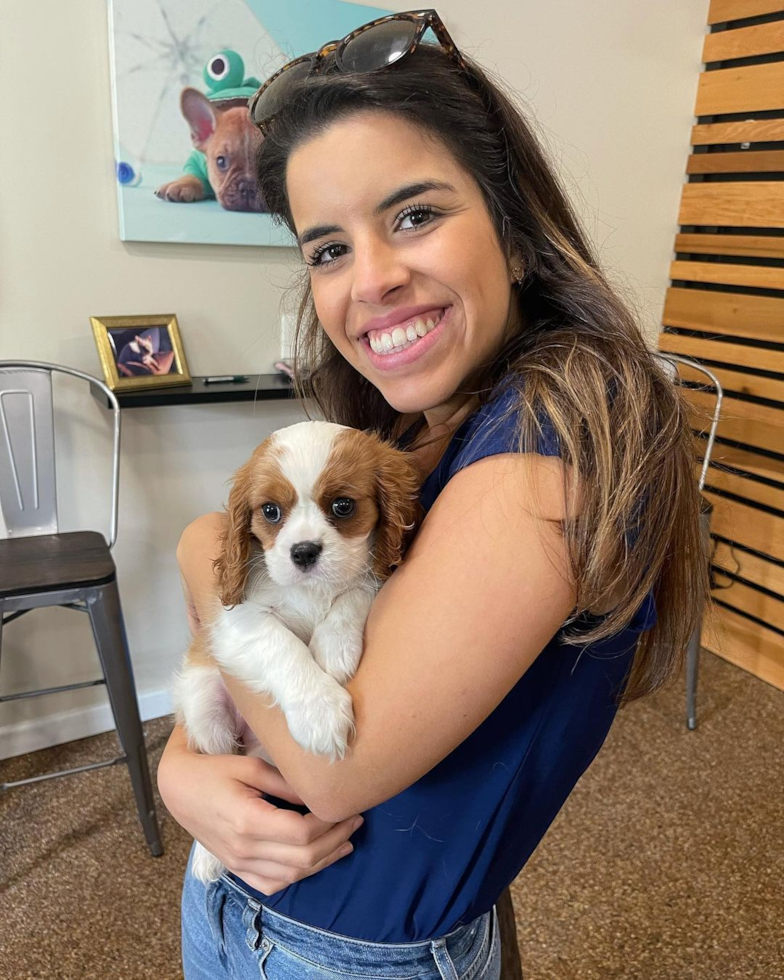Cavalier King Charles Spaniel

Renowned as the perfect lapdog and considered one of the most regal breeds out there, the Cavalier King Charles Spaniel is a joy to have around. This breed's charming persona, combined with its royal lineage, has been capturing hearts for centuries. As they trot along with their feathered tails wagging in sync, Cavaliers carry an air of nobility that's simply hard to resist.
Cavalier King Charles Spaniels, often referred to simply as 'Cavaliers', are small dogs with big personalities. Their compact size doesn't hinder their playful, energetic nature – they're just as happy chasing a butterfly as they are lounging on your lap. Their love for both play and relaxation makes them excellent companions for families and individuals alike.
A Cavalier's soft, expressive eyes are a window to their affectionate and gentle souls. The breed is known for its friendliness and adaptability, eagerly greeting family, friends, and even strangers with the same enthusiastic tail wag and eager-to-please attitude.
Their silky coats, in colors of Blenheim (chestnut and white), tricolor, black and tan, or ruby, are a sight to behold, adding to their appeal. They are a graceful and well-balanced breed, possessing a smooth, effortless gait that's reminiscent of their spaniel ancestors.
While they carry the sophistication of royal spaniels, Cavaliers are sturdier and more robust than they look. They adore being part of everyday family life and won't shy away from any fun or frolic. These Spaniels have a strong desire to please – a trait that, along with their natural intelligence, makes them quite trainable.
Characteristics
- Sociable and Affectionate: Cavaliers are renowned for their friendly and affectionate demeanor. They adore their families and are incredibly fond of cuddling. Cavaliers are not known to be reserved or aloof, rather, they tend to greet almost everyone they meet with wagging tails and eager licks.
- Adaptable Companions: Cavalier King Charles Spaniels are highly adaptable dogs. Whether living in a suburban house with a large yard or a city apartment, they can adjust to various living conditions as long as they're with their beloved humans. Their adaptable nature also extends to their ability to get along with other pets in the household.
- Eager to Please: Known for their eager-to-please attitude, Cavaliers excel in training sessions. They respond well to positive reinforcement techniques and are always keen to win the praise and approval of their owners. This trait makes them excellent candidates for various dog sports such as agility and obedience.
- Moderate Energy Levels: Cavaliers possess a balanced energy level. They are not as hyperactive as some breeds, nor are they couch potatoes. A couple of short walks paired with some playtime can generally keep a Cavalier happy and healthy.
- High Intelligence: Cavaliers are known for their smarts. This, combined with their eagerness to please, makes them highly trainable. Their intelligence is not just limited to learning commands, as they are also skilled at picking up on their owners' moods, making them excellent companion animals and therapy dogs.
- Sensitive Souls: Cavaliers are sensitive dogs. They don't respond well to harsh training methods or negative environments. They thrive in homes where they are loved and treated with kindness. Their sensitivity also translates into their intuitive understanding of human emotions, often acting as a comforting presence during stressful times.
- Luxurious Coats: The Cavalier's coat is one of their defining features. With their long, silky fur and rich colors, Cavaliers are undeniably eye-catching. Their coat, while beautiful, does require regular grooming to keep it looking its best. Regular brushing can help prevent matting and tangling and keep your Cavalier looking regal.

Appearance
The appearance of the Cavalier King Charles Spaniel is akin to a living, breathing portrait from the past, reflecting the grace and charm of their royal namesakes. One look at a Cavalier, and it becomes clear why these dogs have been beloved by nobility for centuries.
A small to medium-sized breed, Cavaliers usually weigh between 13 to 18 pounds, standing about 12 to 13 inches tall at the shoulder. Their proportions make them a perfect choice for those seeking a not-too-big, not-too-small breed that exudes elegance without sacrificing sturdiness.
The head of a Cavalier is slightly rounded, and their sweet, expressive eyes are large, round, and dark brown, exuding warmth and friendliness. The ears are set high and adorned with lavish feathering, giving them a regal yet soft appearance.
Perhaps the most recognizable feature of Cavaliers is their silky, medium-length coat, which is often described as lusciously soft to the touch. The coat comes in four distinct color patterns: Blenheim (rich chestnut on pearly white background), Tricolor (black and white with tan markings), Black and Tan (black with tan markings), and Ruby (a solid, rich red). This diverse color palette, along with the breed's generous feathering on the ears, chest, tail, and legs, contributes to the Cavalier's luxurious appearance.
The tail of the Cavalier King Charles Spaniel, generally left undocked, is in perfect harmony with their elegant silhouette. It's covered in a plume of feathery hair and carried happily aloft when the dog is in motion.
Photos
Temperament
The temperament of the Cavalier King Charles Spaniel is as regal as its lineage, yet they are far from being aloof royals. Instead, they are often characterized as friendly, affectionate, and absolutely eager to please. Known for their incredibly adaptable nature, these pooches are as comfortable in a city apartment as they are in sprawling country estates.
Endowed with an expressive pair of puppy-dog eyes, Cavaliers have a knack for connecting with their human companions on an emotional level. They have a tangible sense of empathy, often intuitively tuning in to their owner's feelings. Don't be surprised if your Cavalier cuddles up to you after a rough day, their warmth and quiet companionship serving as a balm for stress and worries.
In true spaniel fashion, the Cavalier King Charles breed is also sprightly, energetic, and brimming with a playful spirit. They adore interactive games and outdoor adventures, always ready to chase a ball, explore a hiking trail, or simply cavort around in a park. This combination of energy and adaptability makes them excellent companions for families with children, the elderly, and everyone in between.
At the same time, their history as lapdogs to nobility shines through their calm demeanor and non-aggressive nature. Their tolerance and gentleness make them amicable companions for other pets in the household.
Despite their adaptability, Cavaliers thrive on companionship and do not enjoy being left alone for long periods. They crave social interaction, and their happiest moments are when they're involved in family activities.
Cavalier King Charles Spaniels are known for their incredibly adaptable nature, making them suitable for various environments. Their intuitive understanding of human emotions makes them excellent therapy dogs.
Check out our blog on understanding canine behavior.
Insights
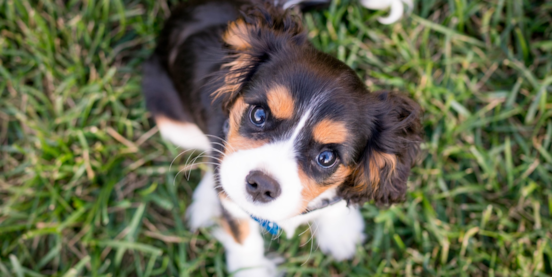
“My dog’s not spoiled, I’m just well-trained”
Puppies are goofy and adorable, and they have a great deal of love to give, there is no denying that. Their tiny paws, little tails, button noses, and expressive puppy-dog eyes often translate to cuteness overload and that’s enough to tame even the wildest of hearts.
Once a puppy arrives at his forever...
Fun household, joyful companionship, lessons on the art of compassion and responsibility, friendship, and love are just a few of the many wonderful things a dog brings to a family with children. Dogs are remarkable creatures capable of much more than we give them credit for.
They are therapists, healers, teachers, loyal friends, and fur babies that love unconditionally and live to please their humans. Having a dog around is not only about fun games and cuddles; it is also about the ...
Care
Grooming
While Cavaliers may look like aristocrats straight out of a 17th-century painting, don't be fooled into thinking they require a royal entourage for their grooming needs. These charming canines come with a coat that, while luxurious, is refreshingly straightforward to maintain.
Firstly, the Cavalier King Charles Spaniel sports a silky, medium-length coat that lacks the typical undercoat seen in many breeds. This means less shedding and fewer matting issues, although regular brushing is still a must. A gentle brush-down several times a week with a slicker or bristle brush can keep their coat free of tangles and looking its glossy best.
Be sure to pay special attention to the Cavalier's feathering—the longer hair on the ears, chest, tail, and legs—as these areas can be prone to knotting. A comb can work wonders in these areas, detangling knots before they evolve into stubborn mats.
In terms of bathing, Cavaliers don't require frequent baths. Every few weeks or so should be enough, or whenever your furry friend decides to take a romp in the mud. Always use a dog-friendly shampoo to preserve the natural oils in your Cavalier's skin and coat.
Ear care is particularly important for Cavaliers, as their beautiful, long ears can also create a warm, moist environment that may lead to infections. Regular checks and gentle cleanings with a vet-approved solution can keep these potential issues at bay.
One element that should be part of every grooming routine is dental care. Brushing your Cavalier's teeth several times a week can prevent tartar buildup and promote overall health. And let's not forget those nails—regular trims can prevent overgrowth and the problems associated with it.
Lastly, grooming is more than a beauty regimen. It's a bonding time, a health check, and a way to keep your Cavalier King Charles Spaniel feeling comfortable and happy. As you groom, check for any skin abnormalities, bumps, or parasites that might have escaped your notice.
While grooming your Cavalier King Charles Spaniel, it's essential to ensure they are comfortable and trust you. Building trust with your dog is crucial, especially during grooming sessions. For more information on how trust can be ruined and rebuilt with dogs, check out our detailed guide.
Brushing your Cavalier's teeth is an essential aspect of their grooming routine. For a comprehensive guide on brushing puppy teeth, check out our dedicated blog post.
Exercise Needs
Even though the Cavalier King Charles Spaniel might strike a regal pose on your sofa, don't be mistaken. Beneath that royal exterior beats the heart of a pup that loves to frolic and play. Yes, these dogs are undeniably affectionate and love to cuddle, but they also require regular exercise to keep them at their happiest and healthiest.
Now, we're not talking about a marathon training level of exercise here. Cavaliers are small dogs with equally modest exercise requirements. A couple of daily walks, around 20 to 30 minutes each, should suffice.
Remember, Cavaliers are sociable creatures and thrive on interaction. So, keep those walks varied and exciting. A stroll through the neighborhood, a romp in a secure dog park, or a hike on a dog-friendly trail could provide excellent opportunities for both physical exercise and social stimulation.
But walking isn't the only form of exercise that a Cavalier King Charles Spaniel enjoys. These dogs were originally bred for hunting, which means they adore a good game of fetch. Toss a ball in your backyard or play a game of chase, and you'll quickly discover the athletic side of your royal fur buddy.
What about those days when the weather isn't cooperating? No problem. Indoor games like hide-and-seek or tug-of-war can provide a Cavalier with mental and physical stimulation. Puzzle toys filled with treats can also be an excellent way to challenge your dog's mind while providing them with a little exercise.
As a breed, Cavaliers are also known to excel in dog sports like agility, obedience, and rally. Not only can these activities provide a great form of exercise, but they also offer an excellent way to deepen the bond between you and your canine companion.
Just remember to monitor your Cavalier during exercise. While they may be energetic, they're still small dogs and can be prone to overexertion. Always ensure your Cavalier has access to fresh water and try to avoid exercising in overly hot conditions.
Health
Although the Cavalier King Charles Spaniel is generally a robust breed, it's prudent for pet parents to be aware of specific health concerns prevalent in these dogs. Being informed about their health predispositions enables owners to provide the best care for their beloved fur buddies.
Like many breeds, the Cavalier King Charles Spaniel is susceptible to certain eye conditions, such as cataracts. Regular eye exams can help spot this condition early, maintaining the quality of life for your furry friend.
Ear infections can be another health concern due to their long, floppy ears that can limit air circulation. Regular ear checks and cleaning can prevent infections from taking hold.
Life Span
A Cavalier King Charles Spaniel's lifespan typically ranges between 9 and 15 years. However, this can vary depending on various factors, including diet, exercise, genetics, and overall healthcare. With appropriate care and attention, these loyal companions can be with you well into their golden years.
Proper nutrition plays a crucial role in extending your Cavalier's lifespan. A diet high in quality protein, balanced with fruits, vegetables, and grains, can help keep your furry friend in optimal health. Also, considering Cavaliers are prone to obesity, keeping their weight in check is vital. Portion control and regular, vet-approved treats can ensure your pet remains at a healthy weight.
Daily exercise also contributes to your Cavalier's longevity. Although they're not as high-energy as some breeds, Cavaliers do enjoy regular, moderate exercise to keep their hearts healthy and stave off boredom. Walks, gentle hikes, and playtime can all contribute to their overall well-being and longevity.
Yearly veterinary check-ups are essential for monitoring your Cavalier's health, especially considering the breed's predisposition to certain genetic health conditions. These regular visits will allow your vet to detect any potential problems early and take the necessary preventative steps or treatments.
Cavaliers are known for their companionship and love of people, meaning a nurturing, affectionate home environment can also contribute to their life expectancy. Emotional well-being is just as important as physical health, so plenty of love, attention, and mental stimulation can help ensure a long, happy life for your Cavalier King Charles Spaniel.
Training
Training a Cavalier King Charles Spaniel, with their naturally sociable and eager-to-please nature, can be a rewarding experience for both pet and owner. This breed is known for its intelligence, adaptability, and love for people, making them great candidates for various training methods.
A key aspect of training any Cavalier is early socialization. Due to their sociable temperament, it's crucial to expose your Cavalier puppy to a variety of people, environments, sounds, and experiences. This helps shape them into well-adjusted, confident adult dogs who are comfortable in diverse settings and situations.
Positive reinforcement is a highly effective training technique for Cavaliers. They respond well to rewards, whether they're tasty treats, encouraging words, or a gentle scratch behind the ears. Remember, these dogs crave your attention and approval, so any training approach should nurture their bond with you rather than instill fear or confusion.
Cavaliers are sensitive dogs and don't respond well to harsh training methods. Negative reinforcement or punishment can cause fear, anxiety, and behavioral issues, so it's best to avoid these methods. Instead, focus on consistency, patience, and positivity during training sessions.
Another significant aspect of training your Cavalier is teaching them to manage their energy levels. While Cavaliers are generally more laid-back than other breeds, they still have bursts of energy that need to be managed. Teach them to enjoy calm, quiet times just as much as they do playtime.
Cavaliers can also be trained for dog sports like agility, obedience, and rally. Their high intelligence and eagerness to please make them good candidates for these activities. Training for dog sports can help keep your Cavalier mentally and physically stimulated, strengthening your bond with them in the process.
Crate training is another crucial part of your Cavalier's training regimen. It not only aids in housetraining but also provides a safe, secure place for your pet to retreat when they need a break. Start crate training early and ensure the crate is a positive, inviting space.
History
Cavalier King Charles Spaniels proudly carry the legacy of their royal roots in their breed's name. Originating in the United Kingdom, this breed's lineage intertwines with the history of European nobility. Spaniels that resembled today's Cavaliers have been depicted in artwork dating back to the 16th century. They've been cherished companions of royalty and aristocracy, their presence constant in court paintings and literature.
The breed's name honors King Charles II of England, who was especially fond of these little spaniels. So smitten was he that he reportedly didn't go anywhere without two or three at his heels. He even issued a decree allowing the King Charles Spaniels in any public place, including the Houses of Parliament, a privilege no other breed could claim.
Despite the breed's popularity, over time, selective breeding led to significant changes in their appearance. Dogs with shorter noses and domed skulls - more akin to today's English Toy Spaniels or King Charles Spaniels (a separate breed) - became the new favorites.
In the early 20th century, an American by the name of Roswell Eldridge offered a cash prize at Crufts Dog Show for anyone who could produce "old-type" spaniels that mirrored the ones in Van Dyck's paintings from the 17th century. His interest spurred the revival of the breed that bore greater resemblance to the original spaniels. The breed, as we now know it, was developed, and the prefix 'Cavalier' was added to distinguish them from their close relatives, the King Charles Spaniels.
Today, the Cavalier King Charles Spaniel is loved for its appearance, which harks back to its royal ancestry, and its personality that blends companionable ease and sprightly spirit. Though they might no longer be constant fixtures in royal courts, their charm ensures they still reign supreme in the hearts of their owners. The breed's fascinating history only adds to the allure, offering a royal touch to this endearing dog breed.
The rich history of the Cavalier King Charles Spaniel intertwines with European nobility. Their royal lineage and regal appearance make them a favorite among many. If you're interested in other breeds with a royal touch or those that are easy to care for, you might want to explore our list of easiest dogs to take care of.



